How to Create Personalized Outreach That Gets Replies [12 Ways]

What's on this page:
Toot toot, Rory Sadler, Co-founder and CEO of trumpet here. 🎺
My goal is to help you build better buyer journeys and generate more revenue.
After all, it’s all about the buyer now. This means sales has to do something differently.
Outreach needs to be about your prospect, and it’s got to be personalized.
So, here are my strategies to create personalized outreach for stronger relationships (and to get higher reply rates). ⬇️
- Know your ICP inside out.
- Categorize your prospects.
- Focus on solving problems.
- Build a social media presence.
- Personalize your cold emails.
- Try a multi-channel approach.
- Guide your prospect.
- Don’t be afraid to bring up competitors.
- Improve every stage in the buyer’s journey.
- Provide personalized demos or trials.
- Follow-up strategically.
- Test and optimize.
1. Know your ICP inside out
Your ideal customer profile (ICP) is the foundation for creating effective outreach.
It’s a detailed description of an organization you believe will benefit the most from your solution.
Here’s what I suggest to look at:
- Company size: This plays an important role in their budget and revenue.
- Industry: If your product or service is only used by a particular industry or niche, your ICP must reflect this.
- Geography: Consider where your company can do business.
- Legality: Any legal requirements your company or the companies you work with must meet.
To truly know your ICP inside out, ask yourself what keeps them up at night.
Or, as Mark Ackers, Co-Founder & Head of Sales at MySalesCoach says:
“SDRs need to know how to speak the language of their ICP. The ultimate questions to be answered are: what is top of mind for your prospect when they go to work? When they get home in the evening, what are they moaning about? Knowing this is how you can improve their lives if they buy our product or service.”
Create a list of target companies, this will provide a roadmap to identify your leads.
2. Categorize your prospects
Not two prospects are the same.
To effectively personalize your outreach efforts, it’s essential to segment your potential customers into categories or personas.
This segmentation could be based on factors like:
- Industry.
- Company size.
- Job title.
- Location.
- Previous interactions.
So, why is segmentation important?
Well, it allows you to send targeted messages to each group, increasing the relevance of your outreach.
For example, you wouldn’t send the same message to a small startup as to a large enterprise.
By tailoring your communication to each segment’s unique needs and preferences, you’ll catch their attention and increase your chances of sparking a conversation.
Here’s what Troy Munson, Account Executive at Proofpoint has to say on this:
“I think that every person in a closing role should organize their territory into tiers, like A, B, C, or D. This helps you identify good potential customers."
"For example, in my previous company, I managed 300 accounts. Out of those, 80 were likely to buy our solution. About 40 fell into tier one because they matched our ICP based on their size, revenue, and LinkedIn activity. "
"The other 40 were decent fits, but the remaining 200 were businesses like manufacturing shops unsuitable for our product. So, I concentrated on those 80 promising accounts rather than wasting time on the others.”
3. Focus on solving problems
Gone are the days of pushy sales pitches and self-centered messaging.
Today’s buyers are savvy, informed, and looking for solutions to their problems. It's not another sales pitch that’ll win them over.
So, you need to shift your mindset from selling products to solving problems. And focus on being value-based at every touchpoint.
Take the time to understand your prospect’s pain points, challenges, and goals to know if your solution can help.
I really like what Lewis Gadsdon, Founder at SDRs of London says on this topic.
He mentions that you don’t need to go overboard with personalization. Instead, instant problem-solving is what will get you results:
“Salespeople are unloading the library when, in fact, the prospect is just looking for a page of a book. So, instant problem-solving is the biggest thing we see right now.”
“Identifying a specific pain point, such as a company needing to improve gender diversity, can be tackled by offering a solution immediately. For example, recommending a highly qualified female candidate with relevant experience often leads to significant results.”
4. Build a social media presence
Social media is your best friend for prospecting and creating personalized outreach. It also increases the effectiveness of personal selling techniques if that’s your approach.
Through social media, you can find key information about prospects and interact with them more personally and meaningfully.
I’d start by identifying the social media channels where your target audience is most active.
Then, create compelling content that educates, entertains, or inspires them. For example, you can share industry insights, thought leadership articles, or behind-the-scenes glimpses of your company culture.
Engaging with your audience by responding to comments, answering questions, and participating in relevant conversations is really important.
You’ll be a trusted authority in your niche by actively participating in the social media community. And increase the likelihood of getting positive responses to your outreach efforts.
But please, don’t get discouraged if you don’t get results from day one. Tom Boston, a Top Social Selling Voice on LinkedIn, has great advice on this:
“It’s so important not to beat yourself up if it doesn’t do very well because two years from now, you’ll thank yourself for the mistakes you made.”
5. Personalize your cold emails
Writing good sales emails doesn’t happen overnight.
Crafting messages that resonate with your prospects takes a lot of iteration and fine-tuning.
It’s not enough to mention their name or company and hope for the best.
So, let me help you ensure those emails don’t land in the spam folder.
First, you’ve got to just get to the point.
If something doesn’t add value, just take it out, particularly with cold emails or LinkedIn.
I explain more about why you need to cut the fluff here. 🎬
Forget: “I hope this finds you well; I’m an SDR at X company”. Openers like this just make the message about you anyway.
Most people look at their emails on their phone. If an irrelevant subject line or email body preview takes up space, it’s going straight in the bin. 🚮
Take note of the do’s and don’ts for your cold email outreach. 👇
💡 Check out prospecting on demand for more tips on cold outreach.
6. Try a multi-channel approach
So, how long do you really spend on multi-channel outreach? Voice notes and videos are often done too sporadically to make a big impact. I’m way more likely to reply if I get two voice notes.
Too many prospectors still put 100 people into their sales sequences and think they’re done for the day. You’ve got to go the extra mile.
- Spend 5 -10 minutes on each prospect in your ICP.
- Find out the information you need to add creative personalization to your outreach.
- Consider your next steps depending on the action taken from your first touchpoint.
Remember, you need to iterate constantly. Your sales cadence will never be a final version. It’s so easy to stay in a routine once you find something that works for you, but different people appreciate unique forms of communication. So, consider the moves from the prospect.
Plus, channels quickly become over-saturated. Maybe videos will lose their novelty soon because everyone’s started doing them. It’s easy to stagnate if you never switch it up.
At trumpet, we evaluate messaging and sequences weekly. We go back to the drawing board and see what else we can do rather than focusing on what is working now. This means we always try new things, fail fast, and constantly improve.
7. Guide your prospect
B2B buying behavior has changed. Ten years ago, sales representatives would’ve been one of the only sources of information. Now, buyers do 70% of the research before they speak to a sales rep, and 72% prefer a rep-free experience.
They’ve also got:
- Websites with ungated demos.
- Review sites.
- Social media.
- Strong communities.
- A network of peers on LinkedIn.
Let’s not forget all these available channels can cause indecision. 👇
You’re not taught how to buy software for your company. Sales needs to do the heavy lifting to guide their prospects through the buying cycle.
- Introduce timelines. Give your buyers visibility of what’s ahead and how long the project will take.
- Create mutual action plans. These add accountability, push deals forward and educate your internal sales champion on what’s involved in making this happen.
- Clarity of the buying experience. Your buyer wants to know what usually happens, what you can help with, and what they need to do.
The big thing here is you’re helping them make a business case for your solution, in a way that can’t be done through other channels. Aside from being a good fit, you’re also explaining what needs to be done at every stage for the implementation to succeed.
8. Don’t be afraid to bring up competitors
If there’s one thing I’d advise sellers to stop doing when it comes to personalized sales outreach, it would be…
⛔ Avoiding questions about competitors. ⛔
Prospects can get all the information they need online, including social proof. Maybe what they find is enough to make a buying decision. But even if they love your solution (or someone else’s), they’ll most likely be doing vendor analysis. It’s just common sense to shop around.
It’s better if you’re able to control the narrative. Be open about the strengths and weaknesses of your competitors.
Bring your competitors up by saying something like this. 👇🐘
“So with company X, who you’re likely to look at for these solutions, they are great at doing X, and are known in the market for this. The reason I believe we are a better fit is because you said a key requirement for you is X. This is an area where our customers say we are very strong in.”
This way, your internal sales champion can take it to their CFO or other decision-makers. We know that as recession uncertainties continue to loom, these stakeholders will always ask their colleagues to fully compare what’s available.
So, If you can help with some of the research and heavy lifting, this will only go in your favor.
9. Improve every stage in the buyer’s journey
Personalization isn’t just coming up with a relevant opening line for your prospecting emails 🙄
It’s a continuous effort across every stage of the buyer journey.
For example:
- The same pitch that engaged your mid-management champion won’t strike a chord with the CFO.
- The customer logos in your sales deck won’t resonate with every prospect.
- Repeating the same demo for every potential client is lazy.
This customized approach also applies to your digital sales rooms.
Imagine tailoring them to reflect not just your brand but co-branded versions or even mirroring your prospect’s brand identity.
80% of buyers care as much about the experience as the product.
At trumpet, we’ve enabled thousands of salespeople to create standout buyer journeys in seconds.
This means:
- Less time spent on admin.
- Less time spent on follow-ups.
- More time spent personalizing.
This strategy can ultimately set your buying journey apart from your competitors.
10. Provide personalized demos or trials
When it comes to selling a product or service, seeing is believing. 👀
That’s why offering personalized demos or trials can be an effective outreach strategy.
Instead of just talking about your product or service, give your prospects a firsthand experience of what it can do.
For example, you can use trumpet to create customised post-demo follow ups.
It's super easy; just pick a template and personalize it with custom variables. You can
address buyers by their name, company name, job title, or team in seconds.
Remember, you don’t have to spend ages creating demos for everyone. Stick to what works at a company level unless it’s a key prospect.
11. Follow up strategically
Following up after an initial connection shows you care and are invested in the relationship.
It’s an opportunity to provide value and stay top-of-mind with your prospects.
Plus, it increases your chances of closing the deal. Even if the opposite happens, and you miss an opportunity, you can find the reasons by following up.
As Jack Neicho, Senior Account Executive at Salesloft says:
“Once I’ve completed that research step, I’ll write a personalized email checking in with them, like going over why they closed last and probably asking if it’s a better time to pick up conversations.”
“It’s all really dependent on the conversation that you had previously. That’s why it needs to be unautomated.”
My quick tips for effective follow-up are…
- Personalize your outreach. Tailor your messages based on previous conversations to show that you’ve been listening and understand their needs.
- Use different communication channels. Mix it up with phone calls, InMails or social media messages to reach your prospects where they’re most comfortable.
- Be persistent (but not annoying). If you don’t hear back initially, give it some time and try again with a different approach. Sometimes, it takes a little persistence to break through the noise.
12. Test and optimize
The key to success in sales is continuous improvement.
That’s why it’s important to constantly test and optimize your outreach efforts to see what works best for your audience.
Experiment with different strategies, messages, and channels to identify what generates the highest response rates and engagement.
Start by setting clear goals and objectives for your outreach campaigns. Define key metrics such as open, response, and conversion rates, and track your progress over time.
You could A/B test different subject lines to see which ones generate the highest open rates.
Elric Legloire, SDR Manager at Agorapulse says:
“Being an SDR, it’s really important to adopt the mindset of a scientist. This comes from the concept of A/B testing, which I initially applied only to email subject lines.”
“Your goal is always to have a testing phase and then make an analysis based on the results. Aim to do that on a weekly basis and decide what works and what doesn’t.”
Or you could experiment with different messaging strategies to see which resonates most with your audience.
You’ll keep your messaging fresh, relevant, and effective by constantly testing and optimising your outreach efforts. Ultimately driving better results and higher reply rates.
Examples of personalized outreach
Let me show you some cold email templates that will help you boost those reply rates. 👇
“Cut the fluff” email
I touched on this previously. It’s really important to keep your emails to the point and cut the fluff.
Here’s an example of an email that does just that. Let me break down why I like it:
- It has a short subject line (remember, 3-4 words is best).
- Short, simple sentences that are easy to read on a phone screen.
- Easy ask, simple question to reply to.
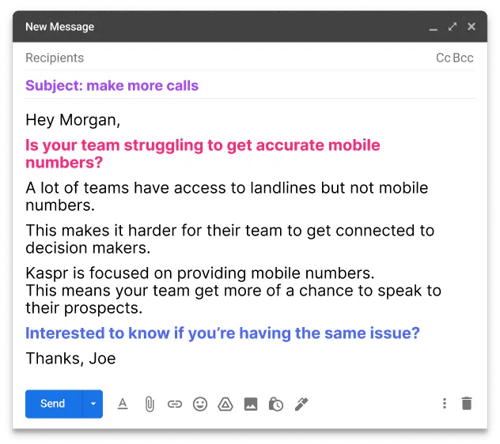
“Opposed to learning more” email
This LinkedIn message proves you don’t need to complicate things to get your point across.
With this one, Thibaut Souyris shows that:
- He’s done his research.
- His message is relevant to the prospect and offers a solution to a pain point.
- The question ‘ opposed to learning more’ makes it intriguing and easy to want to reply.
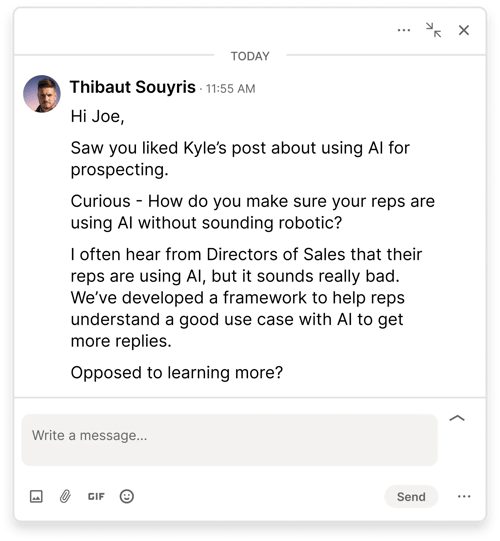
“Help your new hires” email
This email effectively combines personalization, relevance, and a solution-oriented approach.
Here’s why it works:
- Acknowledges their current hiring needs.
- Identifies a specific challenge they might face.
- Offers a relevant solution.
- Prompts further engagement with a question.
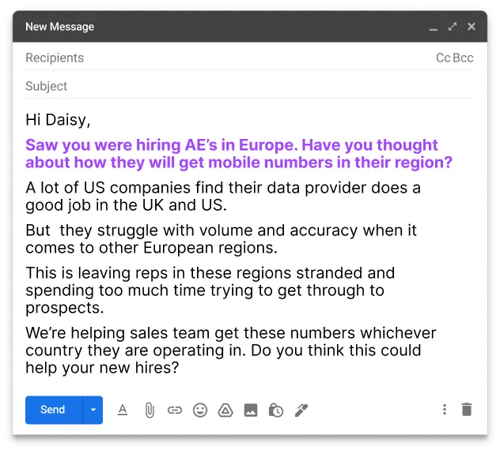
FAQ about personalized outreach
Let’s answer some common questions about personalized outreach. 👇
What is personalized outreach and why it’s important?
Personalized outreach is all about reaching out to prospects in a way that feels tailor-made just for them. It shows that sales reps value them as individuals and aren’t just treating them as another name on a list.
When prospects feel you understand their needs and interests, they’re more likely to engage with you and your message.
Plus, it increases the chances of your outreach being successful because it’s more relevant and meaningful to the recipient.
This helps build trust, strengthens relationships, and can lead to more closed deals for your business.
How to measure the effectiveness of personalized outreach?
To figure out if your personalized outreach is working, you can look at a few different things:
- Open rates. How many people are actually opening your messages?
- Click-through rates. How many people click links or act based on your messages?
- Response rates. How many people are responding positively to your outreach? Even if it’s to say they aren’t interested right now.
- Conversion rates. Are people actually doing what you want them to do, like making a purchase or signing up?
- Customer feedback. What are people saying about your outreach efforts? Are they happy with them, or do they have suggestions for improvement?
What are some common pitfalls to avoid in personalized outreach?
When you’re doing personalized outreach, there are a few things you’ll want to watch out for:
- Over-automation. Using too many automated tools can make your messages feel cold and impersonal. Try to balance automation with manually sent emails.
- Lack of research. It’s important to know your audience before reaching out. Not doing enough research can lead to messages that miss the mark.
- Ignoring feedback. If people are giving you feedback on your messages, it’s important to listen and take it into account. Ignoring feedback can make it harder to connect with your audience.
- Being too intrusive. Personalization is good, but it’s important to respect people’s privacy. You don’t wante to come across creepy after all.
- Inconsistency. Make sure your messages are consistent with your brand and tone. Being all over the place can confuse people and make them less likely to engage with you.
Wrapping up
Personalized outreach isn’t just a nice to have. It’s a must-have.
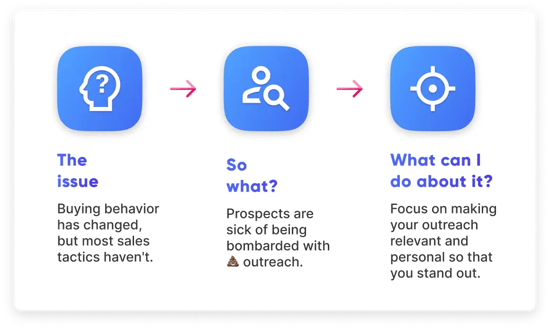
When you put in effort to tailor your messages to each person, you stand out from the crowd.
To recap, here are the ways to create personalized outreach that gets replies:
- Know the language of your ICP and what they moan about to their loved ones of an evening.
- Segment your prospects into categories to send targeted messages - Even better if you can dig for info from users of the current solution.
- Know which channel your audience is most active and go with that one - You need to meet your prospects where they already exist.
- Do the heavy lifting and guide prospects through the buying cycle.
- Don’t be afraid to bring the elephant (your competitors) in the room.
- Let prospects experience your product firsthand with personalized demos and trials.
- Constantly test and optimize your approach - What works now migh not work in a few months or even weeks.
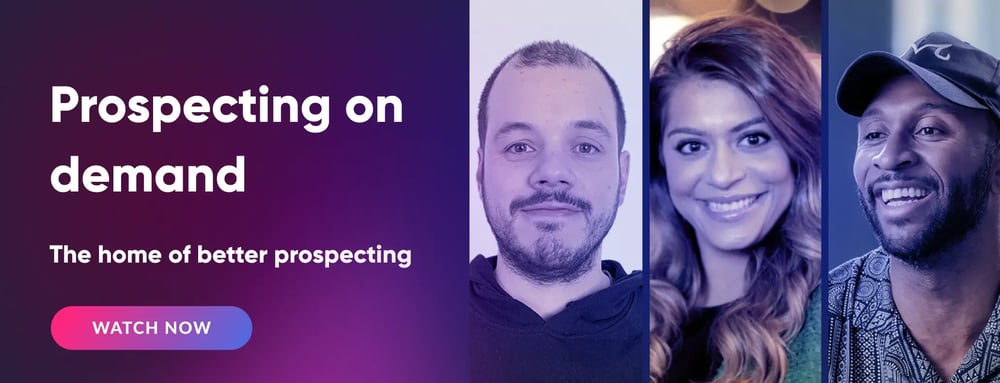


/EN_cold-email-outreach-infographic.webp?width=450&height=656&name=EN_cold-email-outreach-infographic.webp)


